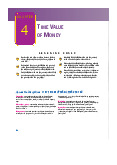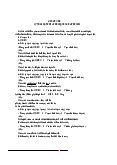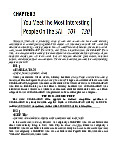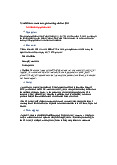













Preview text:
ASSIGNMENT DESCRIPTION
Unit: BUSINESS RESEARCH METHODS Class: BRM-DH48ISB-3
ASSIGNMENT 1. PARTICIPATION (10%)
Description: Every student is required to actively participate in every session of the unit. Each student is expected to:
Participate in at least 80% of the sessions.
Be punctual – grade deduction will be applied to this unprofessional behavior.
Contribute to the sessions by raising questions / giving answers / sharing ideas that are relevant
to the topics discussed. Students who do not raise questions / give answers / share ideas at least
will receive 0 point for the session.
The final score is the average score of the participations in all the sessions of the unit.
ASSIGNMENT 2. TOPIC PRESENTATION (30%)
Description: All the groups study the assigned topics and then, share to all other students of the class.
All the groups explore the assigned topics based on guiding questions. The assigned group(s) give
intensive presentations and discussion to help all class members to completely capture the key knowledge of the topics.
The main contents of the Business Research methods unit are divided into 9 main topics including:
Topic 1: Marketing research process
Topic 2: Exploratory research design
Topic 3: Conclusive research design
Topic 4: Measurement & Scaling
Topic 5: Questionnaire design & sampling
Topic 6: Frequency distribution, cross-tabulation, t-test, analysis of variance and covariance
Topic 7: Discriminant and cluster analysis 2
Topic 8: Correlation, factor analysis and regression
Topic 9: Multi-dimensional scaling and conjoint analysis
Procedure and requirements:
Every topic is assigned to 2 groups.
Students in the assigned groups read the textbook of Marketing research unit, look for necessary
information from other resources and synthesize all the key information logically and appropriately.
Students in the assigned group sprepare and then, submit the ppt file via an assignment in the e-
learning system before the deadline.
The groups in charge give an intensive presentation covering all key aspects of the topic. The
target audiences of the presentation are students in the class and, thus, the presentation should help
them understand the topic thoroughly. For doing this, the group in charge is freely in preparing
necessary stuffs, designing the idea flow, organizing any activities, and selecting appropriate mode to deliver the presentation.
The group in charge submits the hard copy of Individual Contribution Rate clearly specifying the
percentage to which each group member contributes to this assignment. This is used to evaluate the
assignment individually. The template is available in the e-learning system. T
opic 1 : Marketing research process o
Group in charge: Group 1 & group 2 o
Presentation schedule: Session 2 (30/05/2023) o
Guiding questions: Group 1 & group 2 can study topic 1 based on these following guiding questions/requirements: Common re
search type: Customer satisfaction.
What is customer satisfaction research? Which are objectives / purposes of the research?
Which business situations is the research type necessary? Why is it meaningful to businesses?
What are the main characteristics of the research type? 3
Which companies have successfully utilized the customer satisfaction research in their business?
Note: Group can discover more aspects of the research type since these questions are only for guiding purpose. Main discussion:
Marketing research process.
What are the common steps in marketing research process?
What do researchers specifically do in each step in the process?
Discuss on the importance of each step in the process.
How are the steps linked together?
What are key notices about the marketing research process we should keep in our mind? o
Groups can find relevant information from: Chapter 1 of Malhotra (2010) Chapter 2 of Malhotra (2010) Chapter 3 of Malhotra (2010) Chapter 8 of Malhotra (2010) Chapter 9 of Malhotra (2010) Chapter 10 of Malhotra (2010) Chapter 11 of Malhotra (2010) Chapter 13 of Malhotra (2010) Chapter 14 of Malhotra (2010) Chapter 23 of Malhotra (2010)
Any other relevant extra materials o
Deadline of submission: 10:00 PM 29/05/2023 (ppt file only via e-learning system) T
opic 2: Exploratory research design 4 o
Group in charge: Group 3 & group 4 o
Presentation schedule: Session 3 (13/06/2023) o
Guiding questions: Group 2 & group 3 can study topic 2 based on these following guiding questions / requirements: Common re
search type: Market segmentation
What is market segmentation research? Which are objectives / purposes of the research?
Which business situations is the research type necessary? Why is it meaningful to businesses?
What are the main characteristics of the research type?
Which companies have successfully utilized the market segmentation research in their business?
Note: Group can discover more aspects of the research type since these questions are only for guiding purpose. Main discussion:
Exploratory research design.
How is possibly marketing research classified? Identify some approaches used to classify marketing research.
Describe problem solving research, problem identification research, exploratory
research, conclusive research generally.
What are the main characteristics of exploratory research?
Describe specifically some common and useful techniques used in qualitative research:
secondary data, focus group, depth interview, etc.
What should be noticed in using these techniques in doing a qualitative research project? o
Groups can find relevant information from: Chapter 1 of Malhotra (2010) Chapter 3 of Malhotra (2010) Chapter 4 of Malhotra (2010) 5 Chapter 5 of Malhotra (2010) Chapter 6 of Malhotra (2010) Chapter 7 of Malhotra (2010)
Any other relevant extra materials o
Deadline of submission: 10:00 PM 12/06/2023 (ppt file only via e-learning system) T
opic 3: Conclusive research design o
Group in charge: Group 5 & group 6 o
Presentation schedule: Session 5 (22/06/2023) o
Guiding questions: Group 5 & group 6 can study topic 3 based on these following guiding questions / requirements: Common re
search type: Usage and attitudes
What is market segmentation research? Which are objectives / purposes of the research?
Which business situations is the research type necessary? Why is it meaningful to businesses?
What are the main characteristics of the research type?
Which companies have successfully utilized the market segmentation research in their business?
Note: Group can discover more aspects of the research type since these questions are only for guiding purpose. Main discussion:
Conclusive research design.
What is conclusive research and what are its’ main characteristics?
Compare and contrast conclusive research and exploratory research.
Describe specifically descriptive research and causal research:
Which situation they are appropriate to be used?
Which information do these research types provide? 6
Which techniques can researcher use in doing a descriptive and a causal research project?
What should be noticed in conducting a survey and an experiment? o
Groups can find relevant information from: Chapter 6 of Malhotra (2010) Chapter 7 of Malhotra (2010)
Any other relevant extra materials o
Deadline of submission: 10:00 PM 21/06/2023 (ppt file only via e-learning system) T
opic 4: Measurement & scaling o
Group in charge: Group 1 & group 2 o
Presentation schedule: Session 7 (04/07/2023) o
Guiding questions: Group 1 & group 2 can study topic 4 based on these following guiding questions / requirements: Common re
search type: Concept and product test
What is concept and product test? Which are objectives / purposes of the research?
Which business situations is the research type necessary? Why is it meaningful to businesses?
What are the main characteristics of the research type?
Which companies have successfully utilized the concept and product test in their business?
Note: Group can discover more aspects of the research type since these questions are only for guiding purpose. Main discussion:
Measurement & scaling.
What are measurement and scaling and how are they important in research?
Which are scale characteristics? Which are primary scales? 7
Compare and contrast the primary scales
Briefly introduce comparative scaling techniques
Intensively describe noncomparative scaling techniques: continuous rating scale, Likert
scale and semantic differential scale
What is multi-item scale? How to evaluate multi-item scale? o
Groups can find relevant information from: Chapter 8 of Malhotra (2010) Chapter 9 of Malhotra (2010)
Any other relevant extra materials o
Deadline of submission: 10:00 PM 03/07/2023 (ppt file only via e-learning system) T
opic 5: Questionnaire design & sampling o
Group in charge: Group 3 & group 4 o
Presentation schedule: Session 8 (11/07/2023) o
Guiding questions: Group 3 & group 4 can study topic 5 based on these following guiding questions / requirements: Common re
search type: Brand health check
What is brand health check? Which are objectives / purposes of the research?
Which business situations is the research type necessary? Why is it meaningful to businesses?
What are the main characteristics of the research type?
Which companies have successfully utilized the brand health check in their business?
Note: Group can discover more aspects of the research type since these questions are only for guiding purpose. Main discussion:
Questionnaire design and sampling.
Discuss on the importance of survey questionnaire in quantitative research?
Which steps do researcher need to do in designing a survey questionnaire? 8
Describe the steps specifically and identify which should be noticed in doing each step.
What is sampling and how important is it?
Compare and contrast probability and non-probability sampling techniques
Describe specifically probability and non-probability sampling techniques
(convenience sampling, judgmental sampling, quota sampling, snowball sampling,
simple random sampling, systematic sampling, stratified sampling, cluster sampling). o
Groups can find relevant information from: Chapter 10 of Malhotra (2010) Chapter 11 of Malhotra (2010)
Any other relevant extra materials o
Deadline of submission: 10:00 PM 10/07/2023 (ppt file only via e-learning system) T
opic 6: Frequency distribution, cross-tabulation, t-test, analysis of variance and covariance o
Group in charge: Group 5 & group 6 o
Presentation schedule: Session 10 (25/07/2023) o
Guiding questions: Group 5 & group 6 can study topic 6 based on these following guiding questions / requirements: T echnique overview:
What is frequency distribution, cross-tabulation, t-test, ANOVA and ANCOVA?
Which situation, in terms of variables’ characteristic, are these techniques appropriate to be used to used?
Which information can we have from each of these techniques? Give some business
questions that can be answered by them.
Note: Group can discover more aspects of the techniques since these questions are only for guiding purpose. T echnique practicing:
Read the “Description and questions” document to undertand the scenario 9
Analyse the corresponding sample datasets
Demonstrate the analyzing steps in SPSS with sample datasets and interpret the results. o
Groups can find relevant information from: Chapter 15 of Malhotra (2010) Chapter 16 of Malhotra (2010)
Any other relevant extra materials o
Deadline of submission: 10:00 PM 24/07/2023 (ppt file only via e-learning system) T
opic 7: Discriminant and cluster analysis o
Group in charge: Group 1 & group 2 o
Presentation schedule: Session 11 (27/07/2023) o
Guiding questions: Group 1 & group 2 can study topic 7 based on these following guiding questions / requirements: T echnique overview:
What is dicsriminant analysis and cluster analysis?
Which situation, in terms of variables’ characteristic, are these techniques appropriate to be used to used?
Which information can we have from each of these techniques? Give some business
questions that can be answered by them.
Note: Group can discover more aspects of the techniques since these questions are only for guiding purpose. T echnique practicing:
Read the “Description and questions” document to undertand the scenario
Analyse the corresponding sample datasets
Demonstrate the analyzing steps in SPSS with sample datasets and interpret the results. o
Groups can find relevant information from: 10 Chapter 18 of Malhotra (2010) Chapter 20 of Malhotra (2010)
Any other relevant extra materials o
Deadline of submission: 10:00 PM 26/07/2023 (ppt file only via e-learning system) T
opic 8: Correlation, factor analysis and regression o
Group in charge: Group 3 & group 4 o
Presentation schedule: Session 12 (01/08/2023) o
Guiding questions: Group 3 & group 4 can study topic 8 based on these following guiding questions / requirements: T echnique overview:
What is correlation, factor analysis and regression?
Which situation, in terms of variables’ characteristic, are these techniques appropriate to be used to used?
Which information can we have from each of these techniques? Give some business
questions that can be answered by them.
Note: Group can discover more aspects of the techniques since these questions are only for guiding purpose. T echnique practicing:
Read the “Description and questions” document to undertand the scenario
Analyse the corresponding sample datasets
Demonstrate the analyzing steps in SPSS with sample datasets and interpret the results. o
Groups can find relevant information from: Chapter 17 of Malhotra (2010) Chapter 19 of Malhotra (2010)
Any other relevant extra materials 11 o
Deadline of submission: 10:00 AM 31/07/2023 (ppt file only via e-learning system) T
opic 9: Multi-dimensional scaling and conjoint analysis o
Group in charge: Group 5 & group 6 o
Presentation schedule: Session 13 (03/08/2023) o
Guiding questions: Group 5 & group 6 can study topic 9 based on these following guiding questions / requirements: T echnique overview:
What is multi-dimensional scaling and conjoint analysis?
Which situation, in terms of variables’ characteristic, are these techniques appropriate to be used to used?
Which information can we have from each of these techniques? Give some business
questions that can be answered by them.
Note: Group can discover more aspects of the techniques since these questions are only for guiding purpose. T echnique practicing:
Read the “Description and questions” document to undertand the scenario
Analyse the corresponding sample datasets
Demonstrate the analyzing steps in SPSS with sample datasets and interpret the results. o
Groups can find relevant information from: Chapter 21 of Malhotra (2010)
Any other relevant extra materials o
Deadline of submission: 10:00 AM 02/08/2023 (ppt file only via e-learning system)
ASSIGNMENT 3. RESEARCH PROJECT
Description: All groups are required to conduct a research project investigating consumer
characteristics and preferences toward a specific brand / product / service in a certain industry Requirements:



